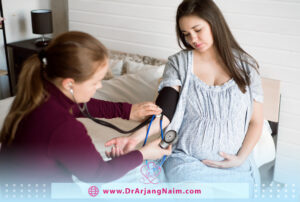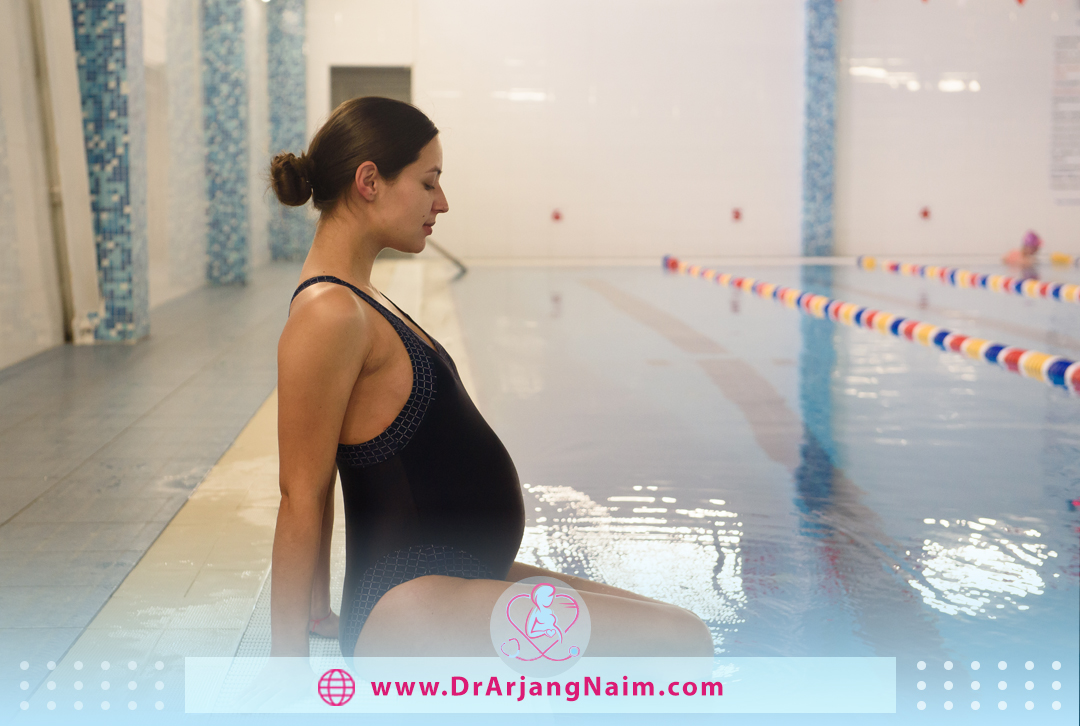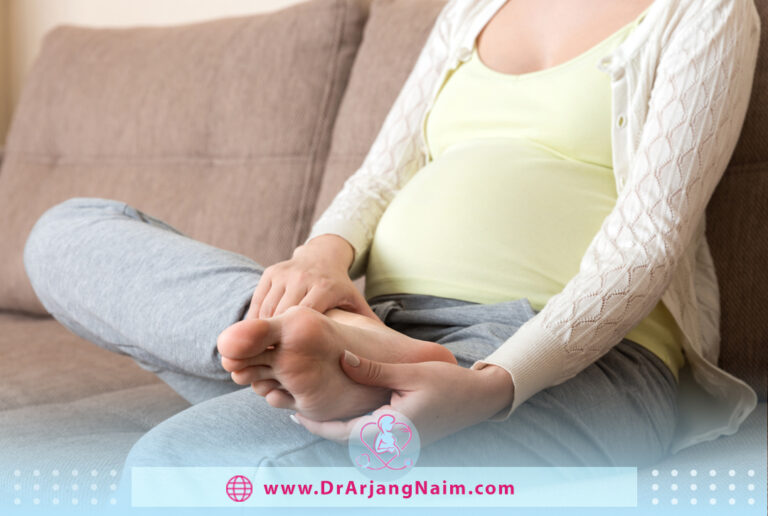Edema(swelling) is a common occurrence during pregnancy. Many expectant mothers experience this symptom due to hormonal changes, increased blood volume, and pressure on the veins caused by the growing uterus. Edema tends to appear around the fifth month of pregnancy and becomes more noticeable as the pregnancy progresses, particularly in the third trimester. It commonly affects the lower extremities, such as the ankles and feet, but can also occur in the hands and face. While Edema during pregnancy is generally harmless, it can cause discomfort and sometimes indicate an underlying condition. Taking measures such as staying hydrated, elevating the feet, engaging in regular exercise, and wearing comfortable shoes can help alleviate the swelling.
Why do women get swollen during pregnancy?
There are three main reasons why women experience swelling during pregnancy.
- More blood than usual is produced during pregnancy to help the fetus grow.
- As the baby grows, the uterus presses and slightly blocks the vessels that return blood from the legs to the heart.
- Hormones soften the veins’ walls, making it harder for them to work properly.
For these reasons, blood tends to pool in the legs. There, a small amount of blood leaks into the tissues through tiny blood vessels, causing swelling that you can see and feel.
First trimester
An increase in the level of the hormone progesterone slows down digestion. This can cause bloat long before the baby develops a noticeable bump. You may also notice some puffiness in your hands, feet, or face (but not much).
If you notice Edema early on, especially if it is accompanied by other symptoms such as dizziness, headache, or bleeding, it is best to contact your doctor or obstetrician.
Second trimester
The second trimester begins at week 14, roughly the beginning of month 4. It’s not unusual to see swollen feet around month 5, especially if you’re on your feet a lot or the weather is hot.
This swelling is due to the increased volume of blood and fluids in the body. Blood volume increases by about 50% during pregnancy, associated with hormonal fluid retention.
Third trimester
Starting at 28 weeks pregnant, the third trimester is the most common time to experience leg swelling. Especially as the weeks go by and you get closer to week 40, your toes look more like little sausages than anything else.
The body continues producing blood and fluids, which can help with swelling. The uterus also gets heavier as the baby grows, which can slow blood flow from the legs to the heart.
In women who experience leg swelling during pregnancy, the swelling typically:
- It is worse in hot weather
- Appears gradually
- At the end of the day, it appears worse
- Lessons when they lie down or raise the feet
- Is equal in both feet
Complications
Sometimes Edema can be a sign of a health problem during pregnancy. Women should contact their doctor or healthcare team immediately if they notice any sudden or rapid increase in swelling.

Preeclampsia
A sudden increase in swelling in the legs can be a sign of preeclampsia. Women may also notice a puffy or swollen face, swelling around the eyes, or sudden swelling in the hands. If the leg swelling is severe, pressing into the skin may cause an indentation for a few seconds. There may also be some discoloration on the legs.
Preeclampsia is a health condition that can occur during pregnancy or after delivery. Preeclampsia causes very high blood pressure and organ problems in pregnant women. It often occurs after 20 weeks of pregnancy or up to 6 weeks after delivery. It can progress quickly and, without treatment, can be very dangerous for the woman and the fetus.
Your doctor may prescribe antihypertensive medications to lower your blood pressure. If the pregnancy has reached 37 weeks or more, healthcare professionals may recommend delivering the baby early.
Deep vein thrombosis
Uneven swelling in the legs or feet may indicate a blood clot, known as a deep vein thrombosis (DVT).
Pregnant women and women who have given birth in the past three months are at higher risk of DVT than women who are not pregnant. This is because blood clots more easily during pregnancy to prevent excess blood loss during labor and delivery. A growing fetus also puts pressure on the legs, reducing circulation. Being less active than usual during pregnancy and postpartum recovery can also reduce blood flow in the legs.
Your doctor may prescribe low molecular weight heparin to prevent or treat blood clots and DVT. They will inject the medicine under the skin.
Medical treatment
Although they may be uncomfortable, leg swelling is a common pregnancy complication. Medical treatment is unlikely necessary, and many women can relieve swelling with home remedies.
However, medical treatment is needed if an underlying disease is causing the leg swelling.
How to get relief
While swollen feet may or may not be painful, they can certainly be uncomfortable or annoying. Fortunately, several simple strategies can be tried to help reduce symptoms during pregnancy.
Reduce sodium intake
One of the ways to reduce swelling during pregnancy is to limit sodium (salt) intake. Salt causes the body to retain excess water. Avoid canned or processed foods, as these foods are high in sodium.
Increase potassium intake
Not getting enough potassium can also make swelling worse. This is because potassium helps the body balance the amount of fluid it retains. A prenatal vitamin should have some extra potassium, but it’s also important to eat good sources of potassium in your diet.
Some foods that are naturally rich in potassium include:
- Bananas
- Spinach
- Beans
- Potatoes with the skin on
- Sweet potatoes, also with the skin on
- Yogurt
- Beets
- Salmon
- Lentils
Some fruit juices, especially:
- Pomegranate
- Orange
- Carrot
- Passionfruit
Reduce caffeine intake
While occasional caffeine isn’t harmful during pregnancy, drinking too much caffeine isn’t good for your baby, it can also worsen swelling. Caffeine is a diuretic, which causes you to urinate more, causing the body to think it needs to retain fluids.

Drink more water
Drinking more water to combat swelling may sound strange, but it works. If your body thinks you’re dehydrated, it will retain more fluid to compensate. Therefore, drink at least ten glasses of water daily so your kidneys remove bad substances, and your body is hydrated. You can flavor your water with lemon, mint, or berries to make it more enjoyable.
Put your feet up and relax
Even if you have a million things to do before the baby arrives, try to sit and put your feet up whenever possible. While sitting all the time is not great for circulation, standing is also hard on a pregnant woman. Elevating your legs, especially at the end of the day, can help drain the fluid accumulated in your legs throughout the day.
Wear loose, comfortable clothing
Tight clothing can worsen swelling, especially around the wrists, waist, and ankles. Prevents blood circulation as easily as possible. Try to wear loose and comfortable clothes (avoid tight elastics).
Stay cool
Especially if you are pregnant during the hot summer months, staying indoors during the heat of the day and avoiding vigorous exercise can help keep you cool and reduce swelling. You can also wear cool clothes, put cold compresses on your feet, or keep a fan nearby.
Wear waist-high compression stockings
If you constantly experience swollen feet or must be on your feet most of the time, you can use compression socks up to the waist. These socks gently compress the legs to help fluid circulation. Avoid compression socks that reach above the knee, as they can be too tight in the middle of the leg and make the swelling worse.
Walk
Even a few 5- or 10-minute walks a day can help improve circulation, which helps reduce swelling. It can also be a nice break in the day and a great way to practice safe pregnancy exercise.
Wear comfortable shoes
Wearing comfortable shoes is key to reducing foot swelling and preventing hip and back problems that can occur with a shifting center of gravity and weight gain.
In addition to the swelling, the body’s ligaments are stretched during pregnancy, so the size of the legs may change. Some people’s feet return to their pre-pregnancy size, but many find that their feet grow half a size or more permanently.

Swim
No studies prove that water pressure reduces swelling during pregnancy, but many people find relief from swelling when they spend time in the pool. Try standing or swimming in a pool where the water depth is almost up to your neck.
Get a massage
Massage helps circulate fluids that tend to accumulate in the legs, reducing swelling.
Sleep on your left side
If possible, sleeping on your left side can improve blood flow and reduce leg swelling. Sleeping on your left side takes the pressure off the uterus from the inferior vena cava, a large blood vessel that returns blood to your heart.
The bottom line
Edema affects about three-quarters of pregnant women. It may start as early as the middle of the second trimester, and once it appears, it will probably last until delivery.
Swelling in the legs is usually a normal feature in the later stages of pregnancy and is nothing to worry about. The body stores excess water during pregnancy. Also, pressure on the fetus can reduce blood circulation in the legs, which causes swelling in the legs. Home remedies for swollen feet during pregnancy include elevating your feet while sitting and wearing loose and comfortable shoes. Drinking plenty of water, doing regular gentle exercise, and avoiding standing for long periods may also help.
If pregnant women notice a sudden increase in swelling in the legs, hands, face, or around the eyes, they should contact their doctor immediately. Sudden swelling can be a sign of preeclampsia, a condition that requires medical treatment. Pregnant women should also contact their doctor immediately if they experience swelling, pain, redness, or uneven warmth in one leg, as these symptoms could indicate DVT.
If you are looking for a doctor to help you during pregnancy and delivery, Dr. Naim provides the best prenatal care in Los Angeles.
Additional questions
- What are the four types of Edemas?
- Peripheral edema
- Pulmonary edema
- Cerebral edema
- Macular edema
- Does walking help swollen legs?
Swimming, walking, and cycling are the most effective forms of exercise to help fight leg swelling.
- What is the management of DVT?
Treatment options for DVT include Blood thinners. These drugs, also called anticoagulants, prevent blood clots from growing. Blood thinners reduce the risk of more clots.
- What is the most diuretic?
Loop diuretics are the most potent because they increase sodium and chloride excretion by preventing sodium and chloride reabsorption. The high effectiveness of loop diuretics is due to the unique location of Henle’s loop in the kidneys.
- What is the main cause of preeclampsia?
Preeclampsia is thought to be caused by the placenta not growing properly due to a problem with the blood vessels that supply it.
References
https://www.whattoexpect.com/pregnancy/symptoms-and-solutions/edema.aspx
https://www.pregnancybirthbaby.org.au/swelling-during-pregnancy
https://www.healthline.com/health/pregnancy/swollen-feet-during-pregnancy#takeaway
https://www.babycentre.co.uk/a230/swelling-oedema-in-pregnancy
https://www.medicalnewstoday.com/articles/swollen-feet-pregnancy#summary




